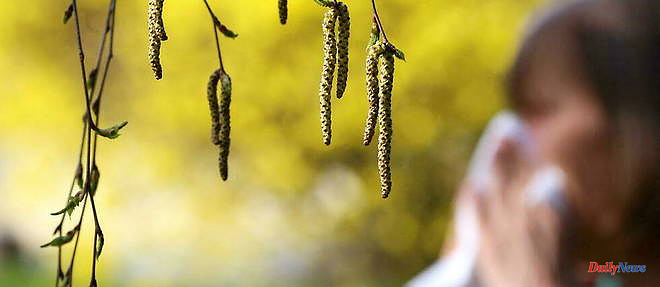Birch pollens present, hornbeam, ash, willow, poplar and plane tree pollens still there… 68 French departments are now on red alert, the National Aerobiological Surveillance Network (RNSA) announced on Friday April 14. The pollen season is well established, to the chagrin of some. The emission of pollen into the atmosphere is the life (plant) that seeks to reproduce: hence these spectacular yellow clouds. But the fact is that pollen transported by the wind contains proteins recognized by the immune system as being allergens. As such, they can trigger an allergic reaction in sensitized subjects.
This profusion of pollen in the atmosphere then becomes an ordeal for allergy sufferers, hence the use in certain situations such as in Durham, North Carolina (USA), in April 2019, of the term "pollenpocalypse" - echoing the strong episodes of air pollution dubbed "airpocalypse".
Through its symptoms, pollen allergy actually causes a real daily difficulty for those affected, going so far as to cause asthma and so-called "cross" food allergies (a person allergic to birch pollen can, for example, develop a food allergy to apples ). More than 10% of the French population is allergic to pollen, and the number of people affected has almost doubled in recent decades.
Presentation of the National Aerobiological Surveillance Network (RNSA) and pollen allergy (pollens.fr).
Can we say today that climate change is an aggravating factor for pollen allergies? Are these pollen clouds early signals of plant adaptation to changing atmospheric and climatic conditions? Will pollen allergies continue to grow in the population?
Answering these questions involves drawing on several scientific disciplines:
● aerobiology (to study the presence of allergens in the atmosphere),
● plant biology (to determine the effects of climate change on plants and their reproduction),
● climate sciences (to make hypotheses about the climate of the coming decades),
● atmospheric chemistry (to analyze the effects of pollutants on pollen),
● medical research (to clarify the links between exposure and sensitization to pollen on the one hand, and allergic symptoms on the other).
The complexity of the subject requires a resolutely transdisciplinary approach, as no one can claim to be a specialist in all these fields and have a general understanding of interconnected systems.
In the light of current knowledge in these various disciplines, and even if it is still difficult to explain the reasons for the explosion of allergies - and that, in this context, any forecast of a future situation remains uncertain -, a certain pessimism is in order: it seems quite possible that pollen allergies will continue to increase during the century.
Also, the start of the pollen season is determined by weather conditions. However, due to the rise in average temperatures, the date of appearance of the first pollen tends to be earlier and earlier for certain plant species. This change in the date of the start of pollination would have little health consequences if it only caused a shift in the pollination period; but the problem is that the date of the end of pollination remains globally the same, leading in fact to an increase in the duration of the pollination period and therefore an increase in the duration of exposure to allergenic pollens.
It should be noted, however, that this trend is not true for all species, and that for some of them pollen emissions have even tended to decrease in recent decades. Climatic conditions also directly influence the geographical distribution of plants. Regarding ragweed, an invasive plant whose pollen is particularly allergenic, studies thus predict a future extension of areas favorable to its presence, which could contribute to the fourfold increase in atmospheric concentrations of ragweed pollen in here in 2050 in Europe.
Moreover, climate change, because it leads to greater quantities of pollen in the atmosphere as well as the occurrence of more intense storms, could also lead to an increased frequency of episodes of storm asthma. These events, favoring a strong dispersion of pollen allergens, are characterized by an influx of consultations in emergency services for asthma attacks in the hours preceding a storm. In November 2016 in Melbourne, the most violent episode of thunderstorm asthma ever recorded occurred in Melbourne: thousands of people consulted in emergency for asthma, nine of whom succumbed.
In addition to the direct effects of climate change, the increase in atmospheric carbon dioxide (CO2) concentrations is likely to amplify the trend of increased pollen production. For example, a study has shown that the CO2 concentrations expected at the end of the century (720 ppm compared to 410 ppm today) could lead to a thirteen-fold increase in oak pollen production. Another study was able to show that with regard to ragweed, the quantity of allergens per pollen grain is correlated with the atmospheric concentration of CO2.
Finally, atmospheric pollutants can, in addition to acting directly on the respiratory system, modulate the allergenic nature of pollens. Allergenic proteins are, for example, modified in quality and quantity by certain pollutants such as nitrogen dioxide and ozone. In addition, polluted, weakened pollen is better able to deliver its allergens, which can then penetrate to the heart of the respiratory system and promote asthma attacks.
As we can see, a body of data leads us to predict a probable increase in the quantities of pollen and allergens in the atmosphere, at least for certain plant species. The effects on the proportion of allergy sufferers in the future population or on the severity of symptoms are uncertain. As a precaution, it nevertheless seems important for public health to take into account possible future changes in exposure to allergenic pollens. Thus, the fight against invasive plants, in particular ragweed, must be a clear priority.
And, if we need more vegetation in our cities, for our well-being, biodiversity and to reduce urban heat islands, taking into account the risk of allergy must become a reflex in the management of urban green spaces. .
*Nicolas Viez, chemist, lecturer, University of Lille, and Marie Choël, lecturer, University of Lille.












